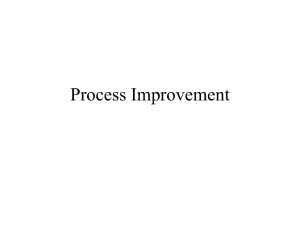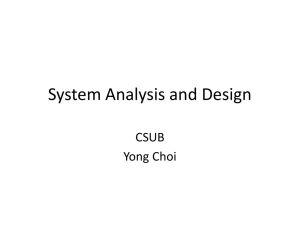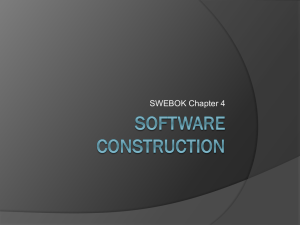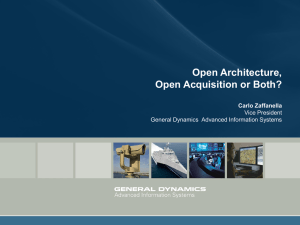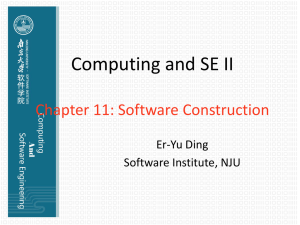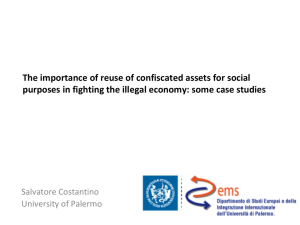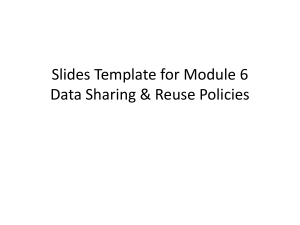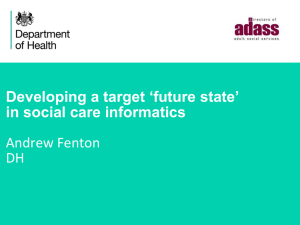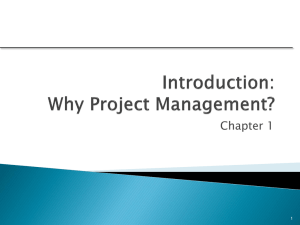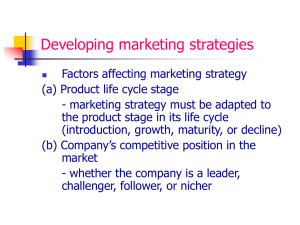Evaluating Products, Processes and Resources(power point)
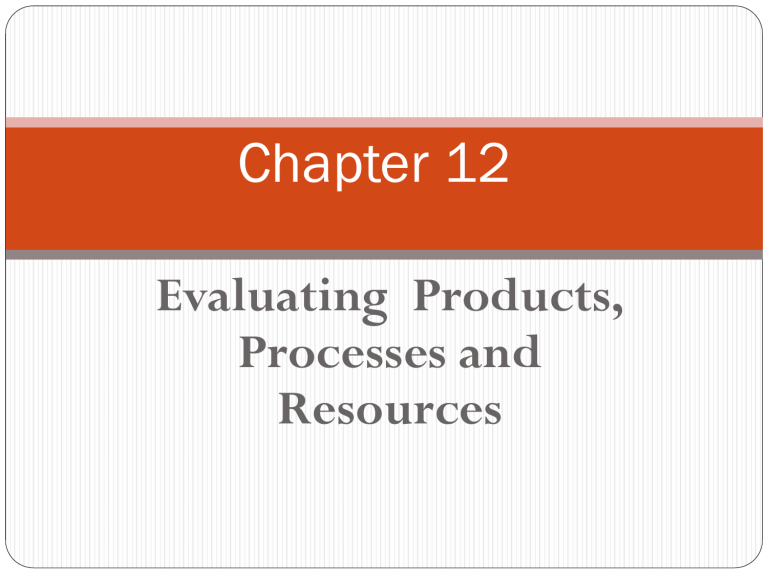
Chapter 12
Evaluating Products,
Processes and
Resources
Contents
12.1 Approaches to Evaluation
12.2 Selecting an Evaluation Techniques
12.3 Evaluating Products
12.4 Evaluating Process
12.5Evaluating Resources
12.6 Chapter summery
12.1 Approaches to Evaluation
Measure key aspects of product, processes, and resources
Determine whether we have met goals for productivity, performance, quality, and other desire attributes
Categories of Evaluation
1. Feature analysis: rate and rank attributes
2. Survey: document relationships
4. Case studies
5. Formal experiment
Evaluation Steps
Setting the hypothesis: deciding what we wish to investigate, expressed as a hypothesis we want to test
Maintaining control over variables: identify variables that can affect the hypothesis, and decide how much control we have over the variables
Making investigation meaningful: the result of formal experiment is more generaliz able, while a case study or survey only applies to certain organization
12.2 Selecting An Evaluation Technique
Formal experiments: research in the small
Case studies: research in typical
Surveys: research in the large
Key Selection Factors
Level of control over the variables
Degree to which the task can be isolated from the rest of the development process
Degree to which we can replicate the basic situation
12.3 Evaluating Products
Examining a product to determine if it has desirable attributes
Asking whether a document, file, or system has certain properties, such as completeness, consistency, reliability, or maintainability
Product quality models
Establishing baselines and targets
Software reusability
Product Quality Models
1. Boehm’s model
2. ISO 9126
3. Dromey’s Model
1. Boehm’s Quality Model
Reflects an understanding of quality where the software
does what the user wants it do
uses computer resources correctly and efficiently
is easy for the user to learn and use is well-designed, well-coded, and easily tested and maintained
1.Boehm’s Quality Model (continued)
2. I SO 9126 Quality Model
Quality Characteristic Definition
Functionality
Reliability
Usability
Efficiency
Maintainability
A set of attributes that bear on the existence of a set of functions and their specified properties.
The functions are those that satisfy stated or implied needs
A set of attributes that bear on the capability of software to maintain its performance level under stated conditions for a stated period of time
A set of attributes that bear on the effort needed for use and on the individual assessment of such use by a stated or implied set of users
A set of attributes that bear on the relationship between the software performance and the amount of resources used under stated conditions
A set of attributes that bear on the effort needed to make specified modifications (which may include corrections, improvements, or adaptations of software to environmental changes and changes in the requirements and functional specifications)
Portability A set of attributes that bear on the ability of software to be transferred from one environment to another (including the organizational, hardware or software environment
3. Dromey Quality Model
Product quality depends on the tangible properties of components and component composition
Correctness properties
Internal properties
Contextual properties
Descriptive properties
Dromey Quality Model Attributes
The six attributes of ISO 9126
Attributes of reusability
machine independence
separability configurability
Process maturity attributes
client orientation well-definedness assurance
effectiveness
Dromey Quality Model Framework
Software Reusability
Software reuse: the repeated use of any part of a software system
documentation
code design requirements test cases
test data
Type of Reuse
Producer reuse: creating components for someone else to use
Consumer reuse: using components developed for some other product
Black-box reuse: using component without modification
Clear- or white-box reuse: modifying component before reusing it
Reuse Approaches
Compositional reuse: uses components as building blocks; development done from bottom up
Generative reuse: components designed specifically for a domain; design is top-down
Domain analysis: identifies areas of commonality that make a domain ripe for reuse
Reuse Technology
Component classification: collection of reusable components are organized and catalogued according to a classification scheme
hierarchical
faceted classification
Example of A Hierarchical Scheme
New topic can be added easily at the lowest level
Faceted Classification Scheme
A facet is a kind of descriptor that helps to identify the component
Example of the facets of reusable code
a application area
a function
an object a programming language an operating system
Component Retrieval
A retrieval system or repository: an automated library that can search for and retrieve a component according to the user’s description
A repository should address a problem of conceptual closeness (values that are similar to but not exactly the same as the desired component)
Retrieval system can
record information about user requests retain descriptive information about the component
Benefits of Reuse
Reuse increases productivity and quality
Reusing component may increase performance and reliability
A long term benefit is improved system interoperability
12.4 Evaluating Process
Postmortem Analysis
A post implementation assessment of all aspects of the project, including products, process, and resources, intended to identify areas of improvement for future projects
Takes places shortly after a projects is completed, or can take place at any time from just before delivery to 12 months afterward
When Post implementation Evaluation Is Done?
Time period Percentage of Respondent
(of 92% organizations)
Just before delivery
At delivery
One month after delivery
Two months after delivery
Three months after delivery
Four months after delivery
Five months after delivery
Six months after delivery
Twelve months after delivery
18.1
1.4
1.4
13.9
4.2
27.8
4.2
22.2
6.9
Postmortem Analysis Process
Design and promulgate a project survey to collect relevant data
Collect objective project information
Conduct a debriefing meeting
Conduct a project history day
Publish the results by focusing on lessons learned
Postmortem Analysis Process:
Survey
A starting point to collect data that cuts across the interests of project team members
Three guiding principles
Do not ask for more than you need
Do not ask leading questions
Preserve anonymity
Postmortem Analysis Process:
Objective Information
Obtain objective information to complement the survey opinions
Collier, Demarco and Fearey suggest three kinds of measurements: cost, schedule, and quality
Cost measurements might include
person-months of effort total lines of code number of lines of code changed or added number of interfaces
Postmortem Analysis Process:
Debriefing Meeting
Allows team members to report what did and did not go well on the project
Project leader can probe more deeply to identify the root cause of positive and negative effects
Some team members may raise issues not covered in the survey questions
Debriefing meetings should be loosely structured
Postmortem Analysis Process:
Project History Day
Objective: identify the root causes of the key problems
Involves a limited number of participants who know something about key problems
Review schedule predictability charts
Show where problems occurred
Spark discussion about possible causes of each problem
Postmortem Analysis Process:
Schedule-Predictability Charts
For each key project milestone, the chart shows when the predictions was made compared with the completion date
Postmortem Analysis Process: Publish
Results
Objective: Share results with the project team
Participants in the project history day write a letter to managers, peers, developers
The letter has four parts
Introduction to the project
A summary of postmortem’s positive findings
A summary of three worst factors that kept the team from meeting its goals
Suggestions for improvement activities
1.
2.
3.
Process Maturity Models
Capability Maturity Model (CMM)
Software Process Improvement and Capability determination (SPICE)
ISO 9000
1. Capability Maturity Model
Developed by Software Engineering Institute
There are five levels of maturity
Each level is associated with a set of key process area
CMM Maturity Levels
Level 1: Initial describes a software development process that is ad hoc or even chaotic
It is difficult even to write down or depict the overall process
No key process areas at this level
Level 2: Repeatable
Repeatable: identifying the inputs and outputs of the process, the constraints, and the resources used to produce final product
CMM Maturity Levels cont….
Level 3: Defined
Defined: management and engineering activities are documented, standardized and integrated
Level 4: Managed
Managed: process directs its effort at product quality
Level 5: Optimizing
Optimizing: quantitative feedback is incorporated in the process to produce continuous process improvement
CMM Key Practices
Commitment to perform
Ability to perform
Activities performed
Measurement and analysis
Verifying implementation
Key Process Areas in The CMM
CMM Level Key Process Areas
Initial
Repeatable
Defined
Managed
Optimizing
None
Requirement Management
Software project planning
Software project tracking and oversight software subcontract management
Software quality assurance
Software Configuration management
Organization process focus
Organization process definition
Training program
Integrated software management
Software product engineering
Intergroup coordination
Peer reviews
Quantitative process management
Software quality management
Fault prevention
Technology change management
Process change management
2.
Software Process Improvement and Capability determination (SPICE)
SPICE is intended to harmonize and extend the existing approaches (e.g., CMM, BOOTSTRAP)
SPICE is recommended for process improvement and capability determination
Two types of practices
Base practices: essential activities of a specific process
Generic practices: institutionalization (implement a process in a general way)
SPICE Architecture for Process
Assessment
SPICE Functional View Activities or
Processes
Customer-supplied: processes that affect the customer directly
Engineering: processes that specify, implement, or maintain the system
Project: processes that establish the project, and coordinate and manage resources
Support: processes that enable other processes
Organizational: processes that establish business goals
SPICE Six Levels of Capability
0: Not performed – failure to perform
1: Performed informally: not planned and tracked
2: Planned and tracked: verified according to the specified procedures
3: Well-defined: well-defined processusing approved processes
4: Quantitatively controlled: detailed performance measures
5: Continuously improved: quantitative targets for effectiveness and efficiency based on business goals
3. ISO 9000
Produced by The International Standards Organization (ISO)
Standard 9001 is most applicable to the way we develop and maintain software
Used to regulate internal quality and to ensure the quality suppliers
12.5 Evaluating Resources
People Maturity Model
Return on investment
People Maturity Model
Proposed by Curtis, Hefley and Miller for improving the knowledge and skills of the workforce
It has five levels
Initial
Repeatable
Defined
Managed
Optimizing
People Maturity Model Cont…
Level Focus Key Practices
1: Initial
2: Repeatable
3: Defined
4: Managed
5: Optimizing
Management takes responsibility for managing its people
Competency-based workforce practice
Effectiveness measure and managed, high-performance teams developed
Continuous knowledge and
Skill improvements
Compensation
Training
Performance management
Staffing
Communication
Work environment
Participatory culture
Competency-based practices
Career development
Competency development
Workforce planning
Knowledge and skill analysis
Organizational performance alignment
Organizational competency management
Team-based practice
Team building
Mentoring
Continuous workforce innovation
Coaching
Personal competency development
Return on investment
Use net present value value today of predicted future cash flows
Example:
Cash flows
Initial investment
Year 1
Year 2
Year 3
Year 4
Sum of all cash flows
NPV at 15%
COTS
-9000
5000
6000
7000
-4000
5000
2200
Reuse
-4000
-2000
2000
4500
6000
6500
2162
12.6 Chapter summery
There are several approaches to evaluation, including feature analysis, surveys, case studies, and formal experiments
Measurement is essential for any evaluation
It is important to understand the difference between assessment and prediction
Product evaluation is usually based on a model of the attributes of interest
Process evaluation can be done in many ways
Return-on-investment strategies helps us understands whether business is benefiting from investment in people, tools, and technology
